Ditapis dengan
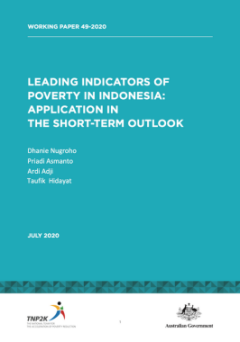
Leading Indicators of Poverty in Indonesia: Application in The Short-Term Out…
Development indicators operate very dynamically in line with the government’s program and policy response. The government, therefore, needs an estimate of the poverty rate for a specific period in line with the development of its constituent indicators. The rate is required by the government to ensure the implemented policy can achieve the target according to the plan. Given the available ind…
- Edisi
- Working Paper 49-2020
- ISBN/ISSN
- -
- Deskripsi Fisik
- PDF, 36 Halaman
- Judul Seri
- Working Paper
- No. Panggil
- 362.509598 NUG. L
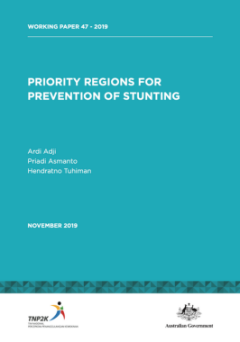
Priority Regions for Prevention of Stunting
One aspect of Indonesia’s health profile that still needs improvement is stunting. In 2018 Indonesia had one of the highest prevalence rates for stunting in the world at 30.8 percent. To achieve the National Medium-Term Development Plan 2015-2019 (Rencana Pembangunan Jangka Menengah Negara: RPJMN) target of a 28 percent stunting rate, in 2018 the government set priority areas for stunting pre…
- Edisi
- Working Paper 47 - 2019
- ISBN/ISSN
- -
- Deskripsi Fisik
- PDF, 28 Halaman
- Judul Seri
- Working Paper
- No. Panggil
- 362.196398 ADJ. P

Harmonisation of Susenas and Riskesdas
To succeed in implementing programs to reduce the number of stunted children, accurate and timely data and information are required to serve as the basis for target and goal setting. The use of Riskesdas (Riset Kesehatan Dasar: Basic Health Research) is highly important to generate indicators on the Indonesian people’s health status and monitor the success of various government programs in th…
- Edisi
- Working Paper 43 - 2019
- ISBN/ISSN
- -
- Deskripsi Fisik
- PDF, 20 Halaman
- Judul Seri
- Working Paper
- No. Panggil
- 362.109598 ADJ. H
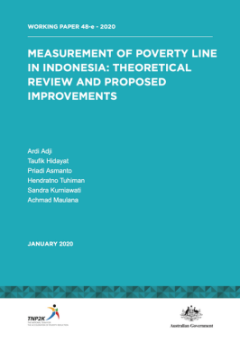
Measurement of Poverty Line in Indonesia: Theoretical Review and Proposed Imp…
Poverty is essentially the inability to meet certain basic needs such as food, clothing, and shelter. The measurement of poverty commonly used in developing countries is absolute poverty, which compares household income or expenditures and the poverty line. The line is based upon the minimum expenditures or income needed to obtain: (i) a quantity of food to fulfill certain calorie needs; and (i…
- Edisi
- Working Paper 48-e - 2020
- ISBN/ISSN
- -
- Deskripsi Fisik
- PDF, 30 Halaman
- Judul Seri
- Working Paper
- No. Panggil
- 362.5 ADJ. M
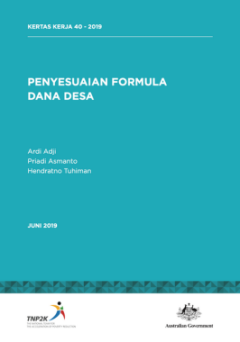
Penyesuaian Formula Dana Desa
Undang-Undang Nomor 6 Tahun 2014 tentang Desa membawa perubahan mendasar dalam pengelolaan, pengaturan dan pelaksanaan pemerintahan desa. Khusus keuangan desa, UU tersebut mengatur sumber pendapatan desa yang dapat berimplikasi pada alokasi anggaran khusus bagi desa, baik yang bersumber dari Anggaran Pendapatan dan Belanja Negara maupun Anggaran Pendapatan Belanja Daerah. Sejak tahun 2015, alok…
- Edisi
- Kertas Kerja 40 – 2019
- ISBN/ISSN
- -
- Deskripsi Fisik
- PDF, 22 Halaman
- Judul Seri
- Working Paper
- No. Panggil
- 352.14 ADJ. P
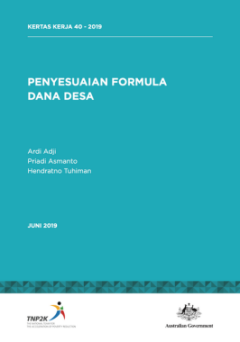
Penyesuaian Formula Dana Desa
Undang-Undang Nomor 6 Tahun 2014 tentang Desa membawa perubahan mendasar dalam pengelolaan, pengaturan dan pelaksanaan pemerintahan desa. Khusus keuangan desa, UU tersebut mengatur sumber pendapatan desa yang dapat berimplikasi pada alokasi anggaran khusus bagi desa, baik yang bersumber dari Anggaran Pendapatan dan Belanja Negara maupun Anggaran Pendapatan Belanja Daerah. Sejak tahun 2015, alok…
- Edisi
- Kertas Kerja 40 - 2019
- ISBN/ISSN
- -
- Deskripsi Fisik
- PDF, 22 Halaman
- Judul Seri
- Working Paper
- No. Panggil
- 352.1409598 ADJ. P
 Karya Umum
Karya Umum  Filsafat
Filsafat  Agama
Agama  Ilmu-ilmu Sosial
Ilmu-ilmu Sosial  Bahasa
Bahasa  Ilmu-ilmu Murni
Ilmu-ilmu Murni  Ilmu-ilmu Terapan
Ilmu-ilmu Terapan  Kesenian, Hiburan, dan Olahraga
Kesenian, Hiburan, dan Olahraga  Kesusastraan
Kesusastraan  Geografi dan Sejarah
Geografi dan Sejarah